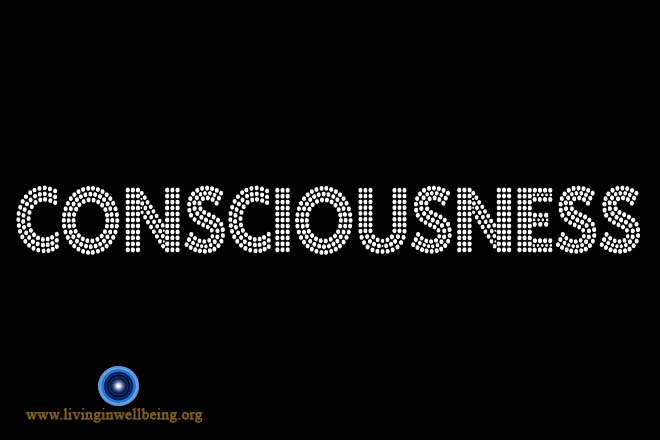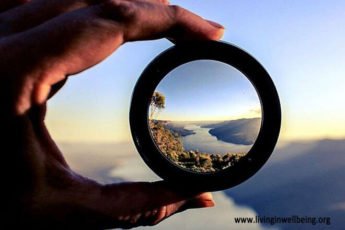
The mind can be divided into two independent realms: the conscious and subconscious. The conscious and subconscious are two different spheres of activity within one mind. The conscious mind, or rational mind, is related to reasoning, logic, selectivity, comparison, analysis, learning and understanding. Our waking awareness is seated in the conscious mind, which uses the five physical senses to perceive the material world. The subconscious mind, as the name suggests, exists below the level of conscious awareness. The subconscious mind is the majority of the mind; the conscious mind, while the most evolved part of the brain, is only a very small portion of the total. The subconscious mind is extremely powerful, capable of processing many times more information than the rational mind. However, it is irrational, does not reason, and cannot differentiate between ideas such as good and evil, or positive and negative. The subconscious mind accepts whatever is impressed upon it. Phrased differently, the subconscious mind is habitual and behavioral.
Researchers have shown that 90% of our daily behavior is managed by the programming of our subconscious mind. It is therefore very important to control the subconscious mind's programming, because it can work against us. The programming of the subconscious mind begins in early childhood; children's minds are easily programmable since the conscious barriers and filters present in adult minds are still being created, and are not yet strong enough. Children absorb all the information they are given, including their very self image, from others without selecting or filtering it. A person's first programmers are his or her parents and caretakers. In addition, the habitual thoughts of the conscious mind can impress themselves upon the subconscious mind. Therefore, one must monitor his or her habitual thoughts, determine whether they are constructive or destructive, and try to adjust his or her thinking accordingly.
Spiritualism, based on some metaphysical principles and interpretations of quantum theory, gives absolute importance to the subconscious law, which states that whatever one impresses upon the subconscious mind becomes that person's reality. This theory states that individual reality is quite literally created through the subconscious mind.
According to quantum theory, matter, and therefore the physical universe is nothing but vibrating energy. However, the universe is structured in layers, and only the outermost layer is physical. The deeper layers are more dynamic, more powerful, more intelligent, more fluid, and more subjective. The energy concentrated in the subatomic level is only to be imagined. In the very deepest level of the universe, time and space do not exist; it is just information, or consciousness. Both matter and energy stem from this undifferentiated existence called consciousness.
The non-locality principle of quantum physics implies that everything in the universe is interconnected at some deeper levels of reality. It has been proven that subatomic particles communicate with each other instantaneously despite the distance separating them. The most popular scientific interpretation of non-locality principle is that the separation between particles is an illusion. Therefore, the human mind is non-local, not at the conscious level, but at the deeper levels of reality where quantum particles communicate beyond time and space. The mind, as part of the universe, also operates at various levels. In the most simplified terms, the layers of the human mind are consciousness, subconsciousness and super consciousness. The conscious mind is a person's free will, and the most superficial layer of the mind. The next layer is the subconscious, which is more powerful and more intelligent. The subconscious mind connects with the inner or spiritual worlds, or the deeper levels of reality. While the conscious mind is the objective mind, the subconscious mind, being connected with the deeper levels of reality, is the subjective one. Spiritualism states that people can create their own reality on these different levels. To consciously create one's reality on the physical layer, the outer reality, a person needs to use his or her objective and rational conscious mind. Creating this way requires effort, but there is another way, a very powerful and effortless way of creating that outer reality from deeper levels, through the subconscious mind. The subconscious is connected to or merged with the universal consciousness which governs the universe.
Spiritualism believes that the subconscious mind has many functions and many abilities. The subconscious mind controls all the body functions, and can heal the body when it is sick or injured. This is because outer reality is a reflection of subconscious beliefs. The subconscious accepts whatever one believes is real and will make it that person's outer reality. The subjective mind also has the ability to understand the thoughts of others without using the ordinary physical senses. This is also known as telepathy, which is, simply put, a communication at the subconscious level.
Spiritualism states that the subconscious has the answer to any and all problems, and can accomplish any task if one simply trusts it.
The power of the subconscious mind is also known from the materialistic point of view, wherein it is endowed with a very powerful neural program which processes incredible amounts of information (the subconscious thought processor). The difference between this and Spiritualism is that according to the materialistic viewpoint, the subconscious mind can only receive information from the physical senses. It records everything we see or hear and absorbs much more information than the conscious mind is aware of. According to the materialistic view, the subconscious brain is just a preprogrammed machine that needs to be managed. However, our subconscious is not an unthinking machine that needs to be controlled by rationality, but an intelligent, purposeful, active and independent guide to our being. The idea of controlling it stems from the fact that the subconscious respects the will of the conscious mind, even when the subconscious mind plays a destructive role. Its importance should not be underestimated; the subconscious mind, in cooperation with external stimuli, has created the conscious mind, the last stage of evolution. However, even with all the power the subconscious possesses, the conscious mind has a very important purpose as well. It is the gatekeeper which protects people from false impressions of others, as the subconscious mind is very vulnerable to suggestion. The conscious mind is the seat of individuality. It is one's freewill, or the Ego.
The subconscious thinks in pictures and images and has its own symbolic language. The subconscious brain monitors the environment for cues that prompt it to awaken and engage the conscious mind. It is the master of the inner realities, but in our physical reality it has left the conscious mind in charge. The conscious mind can mark certain cues from the external environment and ask the subconscious to alert it to those cues. Thus, it is to be mentioned again that the subconscious brain constantly monitors all the external cues around it, but alerts and engages the conscious only for some of them.
Moreover, when one has to deal with large amounts of information, subconscious thinking is superior to the rational mind. People can use what is sometimes called "intuition" in problem solving and decision making, because it enables them to cope with complex information in a natural way. This is because intuition is just subconscious thought, and is therefore much faster and more powerful than rational thought.
It is very important to align subconscious programs with the conscious mind, or else the subjective mind can sabotage the work of the rational mind. If the two are not in harmony, the subconscious can work against the desires of conscious mind. Whenever the conscious and subconscious come into conflict in this manner, the subconscious usually overpowers the rational mind. It takes a great deal of willpower to overcome subconscious programming. Even if one succeeds, the effort can be more energy-draining than many people realize. However, there is another way to rewrite one's adverse subconscious programs by circumventing the conscious barriers. The best time for this is when one is in a sleepy, drowsy or relaxed state. At this time, conscious resistance is reduced to a minimum. Additionally, impressing thoughts upon the subconscious mind is more effective when those thoughts are emotionally charged, be those emotions positive or negative. It is important to mention that people often program their subconscious unwillingly as well. When people focus constantly on undesirable situations, or struggle too much for something, they unconsciously impress limiting beliefs upon themselves. Thus, it is advisable to spend time thinking about what one does want, rather than what one doesn't.
The Principle of Duality states that everything in universe has two opposite poles. The mind, too, is subject to duality: consciousness and the subconscious are its two poles. Whenever someone lives either too much in the conscious or too much in the subconscious, that person is in an unbalanced state. In other words, being either too much egoist or too much spiritualist results in a mental imbalance. There is a state of being which stays in the center of this duality of the mind. This state could be called Enlightenment. Enlightenment uses the mind as a whole; the conscious and subconscious are fully integrated and used in a holistic or natural way. In this state, the mind is connected to the source of energy and infinite intelligence. In the center of duality the mind is open to all possibilities, to infinite opportunities. In this state people are open to everything and attached to nothing. Having no more expectations, people are no longer in a state of waiting for something to happen. This marks the end of the journey to freedom. When Enlightenment is achieved there are no more mental conflicts or mental conditionings. Someone in this state is no longer resisting the natural flow of life. He respects others for what they are, not for what he thinks they should be; this is because judging others is a reflection of our unconscious fear of not being respected or loved, but in a balanced mental state there is no such fear.
In the center of duality, a person does not need to change him or herself, because he or she understands that changing oneself to satisfy others is just consuming energy and willpower for nothing. Nor does he need to find the truth, because he is the truth. A person trying to find the truth is like a fish in the ocean trying to feel wetness.
It is very important to mention that stepping into the center of duality is a natural process; it comes by itself. It does not need to be forced. If one attempts to force the natural process of becoming enlightened he just postpones it. Achieving the center of duality does not require learning, reading, and effort. People just have to be themselves and learn to follow their intuition. The state of freedom from mental conditioning is an evolutionary shift from a human trying to a human being. But, without experiencing the extremes of duality, one cannot go to the center. It is akin to balancing a perfect scale. Whenever a perfect scale is unbalanced it will balance itself, but not without swinging from one extreme to the other. The universe, like the human mind, is a perfect scale. Beyond time and space, they are balanced. In the confines of time and space, the balance is just a matter of time.














